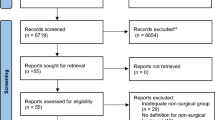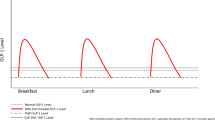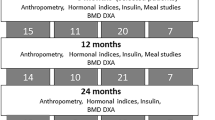Abstract
According to studies, there are many inconsistencies in how IGF-1 levels change after bariatric surgery compared to before surgery, as well as its effects. These discrepancies can be attributed to various factors such as age, body mass index (BMI), and duration of intervention. Therefore, the aim of this study was to evaluate the level of insulin-like growth factor-1 (IGF-1) after bariatric surgery. A systematic review and meta-analysis based on the PRISMA guidelines was conducted from inception until 2021. From 1871 articles initially selected, 24 studies with 28 treatment arms met the eligible criteria and were included. Pooled findings from the random-effects model indicated that IGF-1 levels increased significantly [weighted mean difference (WMD) = 8.84 ng/ml; 95% confidence interval (CI) 0.30–17.39; p = 0.043] after bariatric surgery compared to before surgery. No significant heterogeneity was noted among the studies (Cochran Q test, p = 0.90, I2 = 0.0%). In subgroup analysis, bariatric surgery significantly increased IGF-1 levels at age <40 years but not at age ≤40 years. Bariatric surgery is capable of increasing the IGF-1 levels compared to the period prior to surgery but with a modest clinical magnitude.
This is a preview of subscription content, access via your institution
Access options
Subscribe to this journal
Receive 12 print issues and online access
$259.00 per year
only $21.58 per issue
Buy this article
- Purchase on Springer Link
- Instant access to full article PDF
Prices may be subject to local taxes which are calculated during checkout





Similar content being viewed by others
Data availability
Data are available on request due to privacy/ethical restrictions.
Change history
08 February 2022
A Correction to this paper has been published: https://doi.org/10.1038/s41366-022-01083-6
References
Blüher M. Obesity: global epidemiology and pathogenesis. Nat Rev Endocrinol. 2019;15:288–98.
Santos HO, Lavie CJ. Weight loss and its influence on high-density lipoprotein cholesterol (HDL-C) concentrations: A noble clinical hesitation. Clin Nutr ESPEN. 2021;42:90–2.
Doyle SL, Lysaght J, Reynolds J. Obesity and post‐operative complications in patients undergoing non‐bariatric surgery. Obes Rev. 2010;11:875–86.
Mingrone G, Panunzi S, De Gaetano A, Guidone C, Iaconelli A, Nanni G, et al. Bariatric–metabolic surgery versus conventional medical treatment in obese patients with type 2 diabetes: 5 year follow-up of an open-label, single-centre, randomised controlled trial. Lancet. 2015;386:964–73.
Holst JJ, Madsbad S, Bojsen-Møller KN, Svane MS, Jørgensen NB, Dirksen C, et al. Mechanisms in bariatric surgery: gut hormones, diabetes resolution, and weight loss. Surg Obes Relat Dis. 2018;14:708–14.
Dimitriadis GK, Randeva MS, Miras AD. Potential hormone mechanisms of bariatric surgery. Curr Obes Rep. 2017;6:253–65.
AsghariHanjani N, Vafa M. The role of IGF-1 in obesity, cardiovascular disease, and cancer. Med J Islam Repub Iran. 2019;33:56.
Maccario M, Grottoli S, Procopio M, Oleandri SE, Rossetto R, Gauna C, et al. The GH/IGF-I axis in obesity: influence of neuro-endocrine and metabolic factors. Int J Obes Relat Metab Disord. 2000;24:S96–9.
Frystyk J. Free insulin-like growth factors–measurements and relationships to growth hormone secretion and glucose homeostasis. Growth Horm IGF Res. 2004;14:337–75.
Al-Regaiey K, Alshubrami S, Al-Beeshi I, Alnasser T, Alwabel A, Al-Beladi H, et al. Effects of gastric sleeve surgery on the serum levels of GH, IGF-1 and IGF-binding protein 2 in healthy obese patients. BMC Gastroenterol. 2020;20:1–6.
Brynskov T, Laugesen CS, Floyd AK, Frystyk J, Sørensen TL. The IGF-axis and diabetic retinopathy before and after gastric bypass surgery. Obes Surg. 2017;27:408–15.
Itariu BK, Zeyda M, Prager G, Stulnig TM. Insulin-like growth factor 1 predicts post-load hypoglycemia following bariatric surgery: a prospective cohort study. PLoS ONE. 2014;9:e94613.
Hussain MA, Schmitz O, Mengel A, Keller A, Christiansen JS, Zapf J, et al. Insulin-like growth factor I stimulates lipid oxidation, reduces protein oxidation, and enhances insulin sensitivity in humans. J Clin Investig. 1993;92:2249–2256.
Pellitero S, Granada ML, Martinez E, Balibrea JM, Guanyabens E, Serra A, et al. IGF1 modifications after bariatric surgery in morbidly obese patients: potential implications of nutritional status according to specific surgical technique. Eur J Endocrinol. 2013;169:695–703.
Moher D, Shamseer L, Clarke M, Ghersi D, Liberati A, Petticrew M, et al. Preferred reporting items for systematic review and meta-analysis protocols (PRISMA-P) 2015 statement. System Rev. 2015;4:1.
Stang A. Critical evaluation of the Newcastle-Ottawa scale for the assessment of the quality of nonrandomized studies in meta-analyses. Eur J Epidemiol. 2010;25:603–5.
Higgins J. Cochrane handbook for systematic reviews of interventions. Version 5.1. 0 [updated March 2011]. The Cochrane Collaboration; 2011. www.cochrane-handbook.org.
Hozo SP, Djulbegovic B, Hozo I. Estimating the mean and variance from the median, range, and the size of a sample. BMC Med Res Methodol. 2005;5:13.
Higgins JP, Thompson SG, Deeks JJ, Altman DG. Measuring inconsistency in meta-analyses. BMJ. 2003;327:557–60.
Egger M, Smith GD, Schneider M, Minder C. Bias in meta-analysis detected by a simple, graphical test. BMJ. 1997;315:629–634.
Bruna M, Gumbau V, Guaita M, Canelles E, Mulas C, Basés C, et al. Prospective study of gluco-lipidic hormone and peptide levels in morbidly obese patients after sleeve gastrectomy. Cir Esp. 2014;92:175–81.
Gómez JM, Vilarrasa N, Masdevall C, Pujol J, Solano E, Soler J, et al. Regulation of bone mineral density in morbidly obese women: a cross-sectional study in two cohorts before and after bypass surgery. Obes Surg. 2009;19:345–50.
Di Somma C, Angrisani L, Rota F, Savanelli MC, Cascella T, Belfiore A, et al. GH and IGF-I deficiency are associated with reduced loss of fat mass after laparoscopic-adjustable silicone gastric banding. Clin Endocrinol. 2008;69:393–9.
Galli G, Pinchera A, Piaggi P, Fierabracci P, Giannetti M, Querci G, et al. Serum insulin-like growth factor-1 concentrations are reduced in severely obese women and raise after weight loss induced by laparoscopic adjustable gastric banding. Obes Surg. 2012;22:1276–80.
Guglielmi V, Bellia A, Gentileschi P, Lombardo M, D’Adamo M, Lauro D, et al. Parathyroid hormone in surgery-induced weight loss: no glucometabolic effects but potential adaptive response to skeletal loading. Endocrine. 2018;59:288–95.
Kim TY, Schwartz AV, Li X, Xu K, Black DM, Petrenko DM, et al. Bone marrow fat changes after gastric bypass surgery are associated with loss of bone mass. J Bone Miner Res. 2017;32:2239–47.
Mora MEV, Manco M, Capristo E, Guidone C, Iaconelli A, Gniuli D, et al. Growth hormone and ghrelin secretion in severely obese women before and after bariatric surgery. Obesity. 2007;15:2012–8.
Poulos J, Leggett-Frazier N, Khazanie P, Long S, Sportsman R, MacDonald K, et al. Circulating insulin-like growth factor I concentrations in clinically severe obese patients with and without NIDDM in response to weight loss. Hormone Metab Res. 1994;26:478–80.
Stoeckli R, Chanda R, Langer I, Keller U. Changes of body weight and plasma ghrelin levels after gastric banding and gastric bypass. Obesity Res. 2004;12:346–50.
Vilarrasa N, Gómez JM, Elio I, Gómez-Vaquero C, Masdevall C, Pujol J, et al. Evaluation of bone disease in morbidly obese women after gastric bypass and risk factors implicated in bone loss. Obes Surg. 2009;19:860–6.
Vilarrasa N, San José P, García I, Gómez-Vaquero C, Miras PM, de Gordejuela AGR, et al. Evaluation of bone mineral density loss in morbidly obese women after gastric bypass: 3-year follow-up. Obes Surg. 2011;21:465–72.
Wolf P, Winhofer Y, Smajis S, Kruschitz R, Schindler K, Gessl A, et al. Hormone substitution after gastric bypass surgery in patients with hypopituitarism secondary to craniopharyngioma. Endocr Pract. 2016;22:595–601.
Juiz-Valiña P, Pena-Bello L, Cordido M, Outeiriño-Blanco E, Pértega S, Varela-Rodriguez B, et al. Altered GH-IGF-1 axis in severe obese subjects is reversed after bariatric surgery-induced weight loss and related with low-grade chronic inflammation. J Clin Med. 2020;9:2614.
Katsogiannos P, Kamble PG, Wiklund U, Sundbom M, Espes D, Hammar U, et al. Rapid changes in neuroendocrine regulation may contribute to reversal of type 2 diabetes after gastric bypass surgery. Endocrine. 2020;67:344–53.
De Marinis L, Bianchi A, Mancini A, Gentilella R, Perrelli M, Giampietro A, et al. Growth hormone secretion and leptin in morbid obesity before and after biliopancreatic diversion: relationships with insulin and body composition. J Clin Endocrinol Metab. 2004;89:174–80.
De Marinis L, Mancini A, Valle D, Tacchino R, Bianchi A, Gentilella R, et al. Evaluation of pre-and postprandial growth hormone (GH)-releasing hormone-induced GH response in subjects with persistent body weight normalisation after biliopancreatic diversion. Int J Obes. 1998;22:1011–8.
Engström BE, Burman P, Holdstock C, Ohrvall M, Sundbom M, Karlsson FA. Effects of gastric bypass on the GH/IGF-I axis in severe obesity–and a comparison with GH deficiency. Eur J Endocrinol. 2006;154:53–9.
Giusti V, Gasteyger C, Suter M, Heraief E, Gaillard R, Burckhardt P. Gastric banding induces negative bone remodelling in the absence of secondary hyperparathyroidism: potential role of serum C telopeptides for follow-up. Int J Obes. 2005;29:1429–35.
Juiz-Valiña P, Outeiriño-Blanco E, Pértega S, Varela-Rodríguez BM, García-Brao MJ, Mena E, et al. Effect of weight loss after bariatric surgery on thyroid-stimulating hormone levels in euthyroid patients with morbid obesity. Nutrients. 2019;11:1121.
Pugnale N, Giusti V, Suter M, Zysset E, Heraief E, Gaillard R, et al. Bone metabolism and risk of secondary hyperparathyroidism 12 months after gastric banding in obese pre-menopausal women. Int J Obes. 2003;27:110–16.
Elmlinger MW, Kühnel W, Weber MM, Ranke MB. Reference ranges for two automated chemiluminescent assays for serum insulin-like growth factor I (IGF-I) and IGF-binding protein 3 (IGFBP-3). Clin Chem Lab Med. 2004;42:654–64.
Xie M, Zhong Y, Xue Q, Wu M, Deng X, OS H, et al. Impact of dehydroepianrosterone (DHEA) supplementation on serum levels of insulin-like growth factor 1 (IGF-1): A dose-response meta-analysis of randomized controlled trials. Exp Gerontol. 2020;136:110949.
Kreitschmann-Andermahr I, Suarez P, Jennings R, Evers N, Brabant G. GH/IGF-I regulation in obesity–mechanisms and practical consequences in children and adults. Horm Res Paediatr. 2010;73:153–60.
Schneider HJ, Saller B, Klotsche J, März W, Erwa W, Wittchen HU, et al. Opposite associations of age-dependent insulin-like growth factor-I standard deviation scores with nutritional state in normal weight and obese subjects. Eur J Endocrinol. 2006;154:699–706.
Aguirre GA, De Ita JR, de la Garza RG, Castilla-Cortazar I. Insulin-like growth factor-1 deficiency and metabolic syndrome. J Transl Med. 2016;14:3.
Edén Engström B, Burman P, Holdstock C, Ohrvall M, Sundbom M, Karlsson FA. Effects of gastric bypass on the GH/IGF-I axis in severe obesity–and a comparison with GH deficiency. Eur J Endocrinol. 2006;154:53–9.
Frystyk J, Vestbo E, Skjaerbaek C, Mogensen CE, Orskov H. Free insulin-like growth factors in human obesity. Metabolism: clinical and experimental. 1995;44:37–44.
Frystyk J, Brick DJ, Gerweck AV, Utz AL, Miller KK. Bioactive insulin-like growth factor-I in obesity. J Clin Endocrinol Metab. 2009;94:3093–7.
Laron Z. Insulin-like growth factor 1 (IGF-1): a growth hormone. Mol Pathol. 2001;54:311–6.
Shadid S, Jensen MD. Effects of growth hormone administration in human obesity. Obes Res. 2003;11:170–5.
Mekala KC, Tritos NA. Effects of recombinant human growth hormone therapy in obesity in adults: a meta analysis. J Clin Endocrinol Metab. 2009;94:130–7.
Savastano S, Di Somma C, Angrisani L, Orio F, Longobardi S, Lombardi G, et al. Growth hormone treatment prevents loss of lean mass after bariatric surgery in morbidly obese patients: results of a pilot, open, prospective, randomized, controlled study. J Clin Endocrinol Metab. 2009;94:817–26.
Lewitt MS. The role of the growth hormone/insulin-like growth factor system in visceral adiposity. Biochem Insights. 2017;10:1178626417703995.
Grimberg A. Mechanisms by which IGF-I may promote cancer. Cancer Biol Ther. 2003;2:630–635.
Teixeira FJ, Santos HO, Howell SL, Pimentel GD. Whey protein in cancer therapy: a narrative review. Pharmacological research. 2019;144:245–56.
Calle EE, Rodriguez C, Walker-Thurmond K, Thun MJ. Overweight, obesity, and mortality from cancer in a prospectively studied cohort of U.S. adults. N Engl J Med. 2003;348:1625–38.
Pischon T, Nöthlings U, Boeing H. Obesity and cancer. Proc Nutr Soc. 2008;67:128–45.
Stone TW, McPherson M, Gail Darlington L. Obesity and cancer: existing and new hypotheses for a causal connection. EBioMedicine. 2018;30:14–28.
Ligibel JA, Alfano CM, Courneya KS, Demark-Wahnefried W, Burger RA, Chlebowski RT, et al. American Society of Clinical Oncology position statement on obesity and cancer. J Clin Oncol. 2014;32:3568–74.
Acknowledgements
This study is related to the project No. 1399/4235 from Student Research Committee, Shahid Beheshti University of Medical Sciences, Tehran, Iran. We also appreciate the “Student Research Committee” and “Research & Technology Chancellor” in Shahid Beheshti University of Medical Sciences for their financial support of this study.
Author information
Authors and Affiliations
Contributions
ML, MB, RN, and MHS contributed in conception, design, and statistical analysis. MHS, HS, EM, and SF contributed in data collection and manuscript drafting. MHS and ML supervised the study. All authors approved the final version of the manuscript.
Corresponding author
Ethics declarations
Competing interests
The authors declare no competing interests.
Ethical approval and consent to participate
This study was approved by the research council and ethics committee Shahid Beheshti University of Medical Sciences, Tehran, Iran.
Additional information
Publisher’s note Springer Nature remains neutral with regard to jurisdictional claims in published maps and institutional affiliations.
Supplementary information
Rights and permissions
About this article
Cite this article
Sohouli, M.H., Baniasadi, M., Nabavizadeh, R. et al. Trends in insulin-like growth factor-1 levels after bariatric surgery: a systematic review and meta-analysis. Int J Obes 46, 891–900 (2022). https://doi.org/10.1038/s41366-021-01051-6
Received:
Revised:
Accepted:
Published:
Issue Date:
DOI: https://doi.org/10.1038/s41366-021-01051-6



